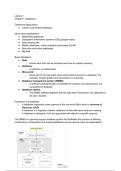Lecture 1
Chapter 1 Databases
Traditional applications:
● numeric and textual databases
More recent applications:
● Multimedia databases
● Geographic information systems (GIS) (google maps)
● Data warehouses
● Mobile databases, online analytical processing (OLAP)
● Real-time and active databases
● Big data
Basic definitions:
● Data:
○ Known facts that can be recorded and have an implicit meaning
● Database:
○ A collection of related data
● Mini-world:
○ Some part of the real world about which data is stored in a database. For
example, student grades and transcripts at a university.
● Database management system (DBMS):
○ A software package/system to facilitate the creation and maintenance of a
computerized database
● Database system:
○ The DBMS software together with the data itself. Sometimes, the applications
are also included
Properties of a database:
- A database represents some aspects of the real world (Mini world or universe of
discourse (UoD)
- A database is a logically coherent collection of data with some inherent meaning
- A database is designed, built, and populated with data for a specific purpose
The DBMS is a general purpose software system that facilitates the process of defining,
constructing, manipulating and sharing databases among various users and applications.
,Typical DBMS functionality
● Define a particular database in terms of its structures, data types, and constraints
● Construct or load the initial database contents on a storage medium
● Manipulating the database:
○ Retrieval: querying, generating reports
○ Modification: insertions, deletions and updates to its content
● Sharing by a set of concurrent users and application programs - yet, keeping all data
valid and consistent
● DBMS may additionally provide:
○ Presentation and visualization of data (table and graphs)
○ Protection or security measures to prevent unauthorized access
○ Maintenance of the database and associated programs over the lifetimes of
the database application
● Applications interact with a database by generating:
○ Queries: that access different parts of data and formulate the result of a
request
○ Transactions: that may read some data and “update” certain values or
generate new data and store that in the database
● Applications can define data authorisation for users
● Applications can keep up with requirements change over time
Example of a database
● Mini-world for the example:
○ List out the main entities in “university” mini-world
■ STUDENTS
■ COURSE
■ SECTION (of COURSEs)
■ GRADE REPORT
■ PREREQUISITE
● Some university concepts:
○ List out the main properties/attributes to describe each STUDENT, COURSE,
SECTION, GRADE REPORT, PREREQUISITE
○ For example: STUDENT: student’s name, student number, and major
○ COURSE: course name, course number, credit hours, and department
○ SECTION: section identifier, course number, semester, year, and instructor
○ GRADE REPORT: student number, section identifier, grade
○ PREREQUISITE: course number prerequisite number
● Some university relationships
○ SECTIONs are of specific COURSEs
○ STUDENTs take SECTIONs
○ COURSEs have prerequisite COURSEs
○ STUDENTs have GRADE REPORTs
,Design of a new application for an existing database or design of a brand new database
starts off with a phase called requirements specification and analysis. These
requirements are documented in detail and transformed into a conceptual design that can
be represented and manipulated using some computerized tools so that it can be easily
maintained, modified, and transformed into a database implementation. The design is then
translated to a logical design that can be expressed in a data model implemented in a
commercial DBMS. The final stage is physical design, during which further specifications
are provided for storing and accessing the database.
In traditional file processing, each user defines and implements the files needed for a
specific software application as part of programming the application. In the database
approach, a single repository maintains data that is defined once and then accessed by
various users repeatedly through queries, transactions, and application programs.
, The main characteristics of the database approach versus the file-processing approach are
the following:
■ Self-describing nature of a database system
■ Insulation between programs and data, and data abstraction
■ Support of multiple views of the data
■ Sharing of data and multi user transaction processing
Main characteristics of the database approach
● Self-describing nature of a database system:
○ The description is called meta-data
○ A DBMS catalog stores the description of a particular database (e.g. data
structures, types and constraints)
○ This allows the DBMS software to work with different database applications
○ Some newer systems such as a few NOSQL systems need no meta-data:
they store the data definition within its structure making it self-describing
Main characteristics of the database approach
● Insulation between programs and data:
○ Called program-data independence
● Data abstraction:
○ A data model is used to hide storage details and the present the users with a
conceptual view of the database
● Support of multiple views of the data:
○ Each user may see a different view of the database, which describes only the
data of interest to that user
● Sharing of data and multi-user transaction processing:
○ Allowing a set of concurrent users to retrieve from and to update the
database
○ OLTP (Online transaction processing) is a major part of database
applications. This allows hundreds of concurrent transactions to execute per
second.
○ Concurrency control within the DBMS guarantees that each transaction is
correctly executed or aborted





